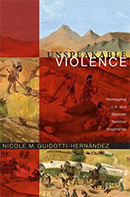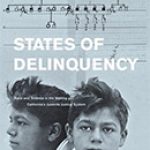Unspeakable Violence: Remapping U.S. and Mexican National Imaginaries

Author: Nicole M. Guidotti-Hernandez
Durham, NC: Duke University Press, 2011. 374p.
Reviewer: Sam Bieler | July 2012
More an investigation of the field of Chicano/Chicana studies than a sociological or anthropological text, Nicole M. Guidotti-Hernandez’s Unspeakable Violence: Remapping U.S and Mexican National Imaginaries offers a remapping of this field more so than a dissection of the violence along the Mexican/American border. Unspeakable Violence has two goals and uses violence at the U.S. Mexican border as the delivery mechanism: to understand somewhat better previously elided or “unspeakable” historical changes; and second, to outline a methodology by which scholars might move away from seeing Borderlands, Latina/Latino and Chicano/Chicana studies purely in terms of narratives of resistance, victimization and mixed racial heritage, or mestizaje. Backed by an impressive selection of primary and secondary sources, Unspeakable Violence is a valuable tool for researchers in these fields, but non-specialist readers on the other hand may find its arguments and structure difficult to follow.
The outstanding feature of Guidotti-Hernandez’s work is the breadth of her scholarly investigation. The book draws on numerous archives to support its arguments, including a foray into literary analysis: Montserrat Fontes’s Dreams of the Centaur is used alongside accounts of the Yaqui Indian Wars and border town lynchings, to build support for the arguments presented. The book is also replete with references to previous works by other scholars, providing an overview of current research in borderlands, Latina/Latino and Chicano/Chicana studies and making it a rich reference for resources in those fields. This focus on research is reflected in the comprehensive descriptions and analysis of the events and works critiqued — dozens of sources are used to provide multiple angles for analysis to support the goals of the book. Unfortunately, this multifaceted approach is also one of the weaker points of the book.
The interweaving of the two goals of understanding unspeakable violence, and providing a new methodology in understanding border violence, does not always occur smoothly. Of these two goals, analysis of the mechanisms of “unspeakable” violence and what techniques can reduce this phenomenon is cited as the primary goal, but often feels like a secondary objective to delivering critiques about various fields of studies; indeed, sociological and anthropological reviews of violence at times feel neglected. Additionally, because these two goals are not smoothly interwoven, it can be difficult to follow the thread of the argument as the book transitions from critiques of the field to studies of violence. Moreover, some parts of the book appear separated from the whole. A post-script on the author’s experiences in Mexico during the election of Barack Obama and a brief reference to Abu Ghraib feel forced and unconnected to the rest of the book.
For scholars of feminist Chicano/Chicana studies, Unspeakable Violence offers an extensive and well researched account of the state of the field as well as inspiration for new methods and directions for research. The book also offers solid historical analyses and detailed records of the events described. Readers outside of this specialty however, may find the shifts in direction and divergent focuses of the book to be a significant challenge when engaging with this scholarship.
Sam Bieler is a research associate at the Urban Institute


